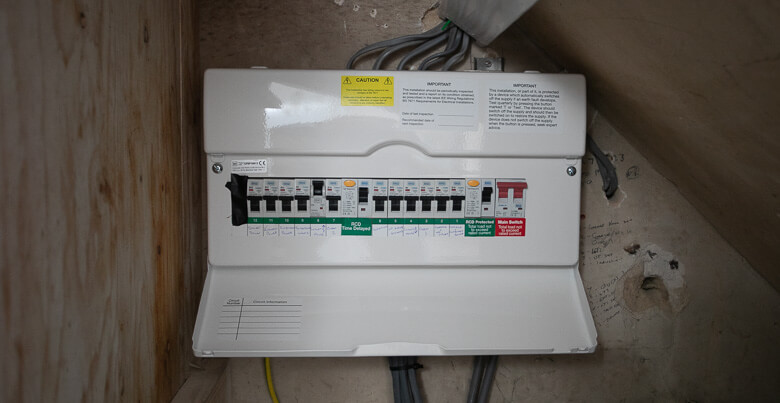The average cost to replace a consumer unit (you might know it as a fuse box) is between £450 and £800.
The price normally includes the replacement of the consumer unit, a test of your electrical installation and the issuing of an Electrical Installation Certificate and Building Regulations Compliance Certificate.
However the cost of replacing a fuse box with a consumer unit, or installing a new one will vary depending on several factors.
Want accurate quotes for your project?
Post a job and electricians near you will get in touch to provide a quote. It’s free, fast and no obligation.
Contents
Average costs for replacing a consumer unit
The table below gives you a rough idea of what to expect when replacing a consumer unit in terms of the cost of the consumer unit and the labour required to install it.
| Unit | Cost of Materials | Cost of Labour | Time |
| 6 circuits | £150 | £300 – 400 | 4 – 5 hours |
| 10 circuits | £180 | £400 – 500 | 5 – 6 hours |
| 12 circuits | £200 | £500 – 600 | 6 – 7 hours |
| Get quotes | |||
Factors that affect the overall cost of the job
- Standard: Costs that apply to the trade as a whole
- Job specific: Costs that are unique to the installation and replacement of consumer units
- Person specific: Costs that are influenced by personal needs and preferences

Standard costs to replace consumer unit
Standard costs include:
- Your location
- The size of your property
- The age of your property
- The necessary materials
- The complexity of the job
The bigger a property is, the more materials, effort and time it requires – all of which increase the cost. Similarly, an older property or complex job will require more time and labour and therefore cost more.
It’s also worth bearing in mind that the rate of labour varies across the country, so where you live (i.e. London vs the north-east) always plays a role.
Free Service
Job-specific costs
Before an electrician can replace a consumer unit, they have to run a series of tests to make sure the replacement can go ahead. These tests are job specific costs.
Visual inspection
The first thing an electrician will do is conduct a visual inspection of your house. This is a basic check to establish the overall condition of your existing installation and identify any visible signs of damage, deterioration or defects.
Bonding and earthing inspection
Next, an electrician will check your earthing and bonding arrangements, as well as your meter tails. The safety of any new work depends on the condition of these, so if they don’t comply with regulations or aren’t in good working order, the work can’t go ahead until the issue is fixed.
Electrical Installation Condition Report
As well as the above, an electrician should ideally conduct an EICR. This will highlight any issues that could not be identified during a visual check and establish the urgency of any problems. An EICR must be carried out by a registered electrician.
Remedial work
If the inspections turn up any faults that will impact the functioning of the consumer unit, these must be fixed before the replacement can go ahead. These could be minor or major tasks and an electrician will discuss the cost and process with you.
Removing the old fuse box/consumer unit and installing a new consumer unit
Removing the old fuse box or consumer unit and fitting a new consumer unit will typically take a few hours (more for larger properties with more circuits), it is this time that accounts for the bulk of the cost of installing the new consumer unit.
Person-specific costs
Person-specific costs of replacing a consumer unit are the factors that are influenced by you and your property.
They include:
- The type of consumer unit
- The number of circuits
- The amp rating
- If you require additional protection
- If you want to relocate the consumer unit
- If you want any additional sockets, switches etc
Before providing a quote, an electrician should ask you about your property, future electrical requirements and budget. This will enable them to recommend the most suitable options.
That said, no one knows your home better than you. So if you can, try to do some research. This will help you communicate your needs as clearly as possible and make sure you are getting the right unit.
Average cost based on a high integrity dual RCD consumer unit at 100A, including certification.
For more information on what the job involves, read our guide on replacing a consumer unit where we cover the process in more depth.
So if you’re ready to get started, post a job to get quotes from electricians near you.
About our data
We survey home owners about the replacing consumer units quotes they receive, and electricians about how much they charge. We use this data to help create our replacing consumer unit cost guide.
Author
Written by, Adam Clark, trade specialist at My Local Toolbox.